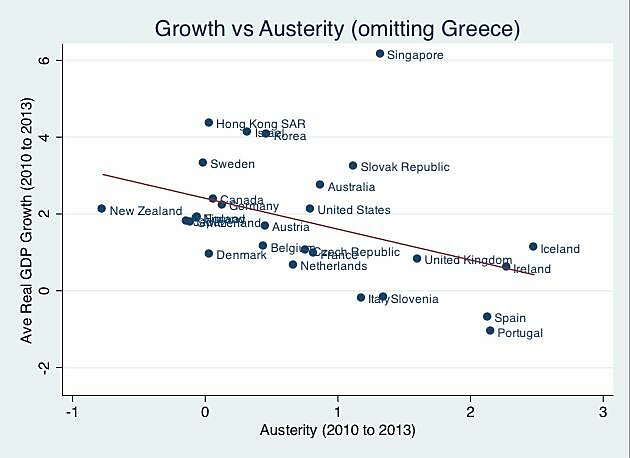Washington Post columnist/blogger Ezra Klein recently echoed the latest White House rationale for additional “stimulus” spending for 2013–15 and postponing spending restraint (including sequestration) until after the 2014 elections. Klein argues for “a 10- or 12-year deficit reduction plan that includes a substantial infrastructure investment in the next two or three years.” In other words, a “deficit-reduction plan” that increases deficits until the next presidential election year.
Citing Larry Summers (who similarly promoted Obama’s 2009 stimulus plan while head of the National Economic Council) Klein says, “There’s a far better case right now for being an infrastructure hawk than a deficit hawk.”
“Deficit hawks tend to [worry that] … too much government borrowing can, in a healthy economy, begin to “crowd out” private borrowing. That means interest rates rise and the economy slows… That’s not happening right now. In real terms — which means after accounting for inflation — the U.S. government can borrow for five, seven or 10 years at less than nothing.… That’s extraordinary. It means markets are so nervous that they will literally pay us to keep their money safe for them.”
If low yields on Treasury and agency bonds simply reflected investor anxiety (unlike stock prices), rather than quantitative easing, then why has the Federal Reserve been spending $85 billion a month buying Treasury and agency bonds? Despite those Fed efforts, Treasury bond yields have lately been moving up rather smartly – even on TIPS (inflation-protected securities). The yield on 10-year bonds rose by a half percentage point since early May. It is not credible to assume, as Summers does in a paper with Brad DeLong, that today’s yields would remain as low as they have been even in the face of substantially more federal borrowing for infrastructure. Even the Fed’s appetite for Treasury IOUs has limits.
A second worry of deficit hawks, according to Klein and Summers, “is a moral concern about forcing our children to pay the bill for the things we bought.…These are real, worthwhile concerns. But in this economy, both make a stronger case for investing in infrastructure than paying down debt.” Paying down debt?! Nobody is talking about paying debt. That would require a budget surplus. The debate is only about borrowing slightly less (sequestration) or substantially more (Obama).
The Summers-Klein argument for larger deficits is that interest rates are very low, so why not borrow billions more for a “substantial investment” in highways, bridges and airports? Summers says, “just as you burden future generations when you accumulate debt, you also burden future generations when you defer maintenance.” This might make sense if there was any link between government tangible assets and federal liabilities. In reality, though, this smells like a red herring. Politicians always say they want to borrow more to build or rebuild highways and bridges. But this is not how borrowed money is spent, particularly when it’s federal borrowing.
Accumulation of federal debt since 2008 − including the 2009 stimulus plan − had virtually nothing to do with investment. Nearly 90 percent of the 2009 “stimulus” was devoted to consumption — $430.7 billion in transfer payments to individuals, more than $300 billion in refundable tax credits, $18.4 billion in subsidies (e.g., solar and electric car lobbies), more pay and perks for government workers, etc. Stanford’s John Taylor shows that even the capital grants to states − ostensibly intended for infrastructure projects − were used to reduce state borrowing and increase transfer payments such as Medicaid.
In the National Income and Product Accounts (NIPA), the closest thing we have to a measure of “infrastructure” is government investment in structures. Federal borrowing in the NIPA accounts rose from $493.5 billion in 2008 to $1,177.8 in 2010, yet total federal, state and local investment in structures was unchanged − $310.1 billion in 2008 and $309.3 billion in 2010. Such investment was lower by 2012, but not because federal borrowing was “only” $932.8 billion that year.
NIPA accounts show only a $12.9 billion federal investment in nondefense structures in 2012 and $8.5 billion for defense structures. By contrast, transfer payments accounted for 61.7 percent of federal spending in 2012, consumption for 28.2 percent, interest 8.5 percent and subsidies 1.6 percent. Consumption is mostly salaries and benefits. Transfer payments did include more than $607 billion in grants to states and localities in 2011, according to a new CBO study, but 81.7 percent of such grants were for health, income security and education, leaving only 10 percent for transportation. Transportation accounted only 3.2 percent of total federal spending in 2012 and nine percent of “discretionary” spending.
In short, direct federal infrastructure investment plus grants to states add up to only a little over $80 billion out of a budget that exceeds $3.5 trillion. If federal borrowing had anything to do with $80 billion a year in federal infrastructure spending, then we wouldn’t have been borrowing about a trillion a year for the past four years.
Klein’s rephrasing of Summers’ rerun of the 2009 “infrastructure” excuse is not a plausible argument for increased federal debt. It is, at best, an argument for ending the chronic misuse of borrowed money to pay for transfer payments and government consumption so that we could prudently reallocate a greater share to transportation infrastructure.

